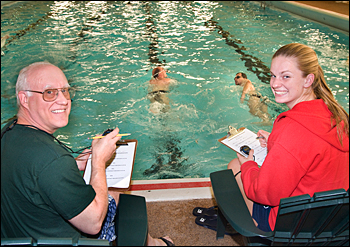Healthfest Swims, Big Turnout
November 4, 2008

Pete Heotis and Jessica McKenna record times of swimmers' laps and lengths.
On Wednesday, October 29, and Friday, October 31, swimmers were seen dotting the Lab pool, clad in swim caps, goggles, Speedos, and...flippers?
This year's Healthfest swim events produced a larger turnout than ever before. From Healthfest first-timers to competitive swimmers and triathletes, 54 swimmers, ranging in age from 27 to 80, completed the 400-yard swim, and 45 swimmers completed the 800-yard swim. Twenty-seven swimmers participated in the biathlon, adding their 800-yard swim times to the five-kilometer fitness run the week before.
For the men, Ralf Seidl smashed the 2004 400-yard Healthfest record by over 30 seconds with a time of 4:40.7. Following in second place was Rob Todd in 5:10, who beat his first recorded time by over two minutes. In third was Pete Heotis in 5:32.
For the women, Beth Mulligan came in first at 6:43, Karen McNulty Walsh came in second at 7:28.5, and in third was Denise Jennings in 7:32.
For the 800-yard swim, Rob Todd came in first at 11:01, followed by Ian Ballantyne in 11:56, and Wlodek Guryn in third at 12:34. For the women, Denise Jennings was first in 15:15, Beth Mulligan was second in 15:19, and in third was Kathy Hershovitz in 15:32.
Siedl, a Lab physicist, used to be a competitive swimmer in his home country of Germany. He has competed in national finals many times between ages 10 and 20.
"Now, I swim for fun and for fitness," Siedl said. "Swimming is a nice way to relax after a workday, and it helps that it is somewhat repetitive. You can clear your mind."
Siedl still trains three times a week around lunchtime at the Lab pool.
Ramiro Debbe, a Lab physicist for 23 years, competed this year for the first time. He has been practicing everyday and finds that swimming helps to lower his blood pressure and cholesterol.
"This is the first time I feel so healthy," Debbe said. "I had no idea that this was so good for me. At my age, you start to feel the effects on your muscles and your heart."
Now, Debbe is working on his endurance, and after that, he hopes to improve his speed.
"And after that, the Olympic games are far away, so you never know," he said.
Cecilia Sanchez, a Lab physicist for 10 years, became serious about swimming at the beginning of 2008, and this was her first Healthfest swim. She practices a few times a week after work and on Saturdays and also plays volleyball twice a week.
"I like sports because they keep me calm," Sanchez said. "I was too busy with physics and took a break from swimming and sports for years. By signing up for a triathlon in October, I forced myself to practice."
Sanchez said she is teaching herself freestyle because she is already satisfied with her breaststroke. That is why she timed her 400-yard swim with her freestyle. Between her Wednesday and Friday swims, she shaved two seconds off her 400-yard freestyle swim.
"Sometimes, even when you push yourself hard, like on the 800-yard swim, you don't see a huge difference," Sanchez said.
Tom Nehring, a Lab electrical engineer, has spent 25 years at Brookhaven and four of them swimming every day at lunch. He enjoys swimming and uses it to control his weight and blood pressure.
"I have a shoulder injury, so this acts as physical therapy too, preventing atrophy to the muscles," Nehring said. "Swimming is low-impact, so there is less joint pain."
Patricia Johnson, a staff member in BNL's travel department for 35 years, was a first-time Healthfest swimmer. She began water aerobics in January 2008, and since September, also swims twice a week.
After her 400-yard swim, Johnson continued to swim a few extra laps for fun.
"I'm a water sign, a Pisces, so I should like the water, right?" Johnson said. "I enjoy the feeling of freedom and floating. No matter what size you are, the water is very buoyant and life-giving."
Many here participated in the winter 2008 virtual swim, "Swim to the Bahamas," and plan to "Swim to Mexico" in January of 2009. Swimmers perform as many laps as they can over a three-month period and plot their distance on a virtual map. For more information on this or on Healthfest statistics, contact Pete Heotis.
2008-961 | INT/EXT | Newsroom









